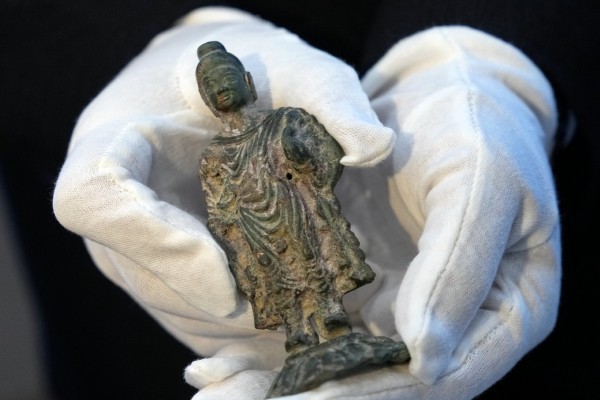Top court hails legal efforts to retrieve relics

An archaeologist displays the standing statuette of the Gautama Buddha discovered in Xianyang, Shaanxi province. [Photo by Li Yibo/Xinhua]
Chinese courts have successfully stepped up efforts in recent years to formulate judicial rules to assist the recovery of the nation's cultural treasures from overseas, an official from the country's top court said on Tuesday.
"We've resolutely supported government departments in charge of relic-related affairs to perform their duties, and we've focused more on urging them to play the role in protecting the relics," Yang Linping, vice-president of the Supreme People's Court, said at a news conference.
She made the remark while detailing 15 influential relic-related cases. A lawsuit involving Zhang Gong Patriarch, an ancient Buddha statue, was a key step by Chinese courts in helping bring home relics through legal measures, Yang said.
The 1,000-year-old statue contains the mummified remains of Zhang Qisan, a monk known for helping people battle diseases and preaching Buddhist doctrines during the Song Dynasty (960-1279).
The significant cultural relic, which had been enshrined at Puzhao Temple in Sanming, Fujian province, for local villagers to worship, went missing in 1995.
Its whereabouts were unknown until it went on display in the Mummy World Exhibition at the Hungarian Natural History Museum in Budapest in 2015, gaining global attention.
In the Sanming Intermediate People's Court in Fujian, the villagers initiated a civil lawsuit against Oscar van Overeem, a Dutch architect and collector, after they failed to reach an agreement with him for the return of the relic.
In 2020, the court ordered Van Overeem to return the statue to Yangchun and Dongpu villages in Fujian.
The Dutch collector appealed to a higher court, claiming he bought the statue in Amsterdam in 1996. But the Fujian Provincial High People's Court upheld the original ruling, saying Van Overeem could not provide any evidence of the transaction.
The high court also identified the statue as a stolen, illegally exported cultural relic, adding it reflected the traditional customs of southern Fujian and holds a special meaning for the villagers.
Guan Qiang, deputy head of the National Cultural Heritage Administration, who also attended the news conference, lauded the case. "It's the first time that Chinese courts have ruled in a matter related to the ownership of the Chinese relics lost overseas," he said.
The case, which attracted attention at home and abroad, demonstrated the courts' upholding of justice, Guan said, adding "it has also opened a new channel — civil litigation — to bring lost or stolen relics back to our country."
He revealed the administration has signed agreements to prevent theft, excavation and illegal entry and exit of cultural relics with 24 countries since the 18th National Congress of the Communist Party of China in 2012. More than 1,800 relics held overseas have been brought back to China, he said.
Data from the top court showed that Chinese courts have concluded 12,407 cases related to relics and heritage items since 2016.







